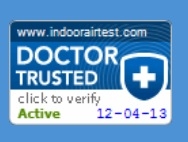News
Indoor Mold Detection 101: A Closer Look
The nature and characteristics of indoor molds are much more variable. Sometimes one can see mold growth in indoor environments with the naked eye. However, it is hard to assess heath and hygiene effects just by looking at it.
Clearwater, FL -- Mold is ubiquitous in nature. Filamentous fungi often produce mold in indoor environments. Excessive moisture, a carbon source, a moderate temperature (25ºC), and dampness, besides other factors, are supportive elements for the growth of mold indoors. The nature and characteristics of indoor molds are much more variable. Sometimes one can see mold growth in indoor environments with the naked eye. However, it is hard to assess heath and hygiene effects just by looking at it. Therefore, it is essential to study the mold in order to understand its impacts. There are a number of techniques available nowadays to isolate and identify the mold from indoor environments. No one technique fits in every scenario, but rather, it should be case specific. Although mold can be examined and evaluated in various ways, an integrated approach to detect mold in indoor environments is described below:
1. Mold sampling
I Air samples
To study the airborne fungi from indoor environments, air samples are collected. Some popular mechanisms are described below for collecting mold/fungal samples from the ambient air.
a. Drum Trap (DT)
Airborne fungal elements are collected on an adhesive tape mounted on a rotating disc powered by an electric motor in an air sealed drum with an orifice. The rotation of the disc is fixed with that of the exposure time. Hirst spore trap, Tilak air samplers, etc. are some common commercially available samplers in this category.
b. Electrostatic Trap (ET)
Fungal/mold samples are collected by drawing air with a constant flow rate and exposure time over media under the influence of an electrostatically charged environment. Charged particles are collected on their appositively charged electrode. An Electrostatic Sampling Device (ESD), SASS® 3100, Portable Biohazard Sampler, etc. are good commercially available samplers under this technique.
c. Filterer Trap (FT)
Air samples are drawn on a filter mounted within a closed, airtight chamber by pulling the air through it with a constant airflow rate and exposure time. Micro-orifice uniform deposit impactor (MOUDI), filter made out of cellulose ester, polyvinyl chloride, and polycarbonate are widely used for mold/fungi sampling.
d. Impinger Trap (IP)
In this method, the sample is collected by dissipating the air into an air tight flask containing the media with a constant airflow rate and exposure time. Some common IP samplers include, but are not limited to, Greenberg-Smith impinger, AGI-30, etc.
e. Pore Trap (PT)
Air samples for mold/fungal evaluation are collected on media in an air-tight cylinder by collecting air through a perforated metal plate with a constant airflow rate and exposure time. Anderson’s, Burked, Bio-culture, and Button Aerosol Samplers are routinely used based on this technique.
f. Rotorod Trap (RT)
The airborne fungal particulates are collected on a strip of sticky tape or surface mounted on a mechanical arm/surface attached to a spindle powered by an electric motor that can rotate with a specific number of rotations per minute for a determined exposure time. Rotorod sampler by Sampling Technology, Inc. is one of the most widely used samplers of this category.
g. Spore Trap (ST)
Commonly in this method, a gel-coated glass slip is employed inside an air sampling device and air is pulled out with a constant air flow for a predetermined exposure time depending on the project goals. Flow rate is verified in the field utilizing an in-line flow meter. Air is passed over the coated slide causing airborne fungal particles to adhere to the gel. Some commercially available devices of this category are Air-O-Cell, Micro 5, Allergenco-D, M2, Burkard volumetric samplers, etc.
h. Thermal Trap (TP)
The air samples are collected on a glass slip by placing it around a hot body into ambient air.
II Surface samples
Environmental surfaces are collected to evaluate the mold/fungal infestation in and around indoor environments. Some practical methods for collecting a surface sample are given below.
a. Bulk Sample (BSAM)
Bulk samples are made by collecting, scraping, or cutting a representative of the material/dust suspected for mold/fungi by using aseptic techniques. These samples are transferred to the laboratory in a sterile container for further analysis.
b. Surface Imprint Sample (SISM)
Environmental samples are collected with the help of sticky tape. The sticky side of the tape is placed over the test area and an imprint is taken in order to collect a surface sample for a mold/fungal evaluation. Bio-Scan400 is the most accurate (cts/m2) and one of the more commonly used products for collecting surface samples for mold/fungi.
c. Swab Sample (SSAM)
Swab samples are made by swabbing a selected area by using sterile techniques. The collected specimens are transported to the laboratory for further enumeration. A number of companies make cotton or polyester swabs which are available in the market for environmental surface sampling for collecting mold/fungi samples.
d. Vacuum Sample (VSAM)
Dust samples are collected from environmental surfaces suspected for mold/fungi with a dust collecting cassette and/or a vacuum sample device under aseptic conditions. The collected samples are transported to the laboratory in a sterile container for further evaluation. Dust sock®, Dust collector, etc. are available in the market for collecting environmental surface samples for mold/fungi.
e. Wipe Sample (WSAM)
Environmental surface samples are collected by means of wiping the selected area suspected for mold/fungi with a sterile gauze pad by following sterile techniques. A leak proof container should be used for transporting these aseptically collected specimens to the laboratory for mold/fungi evaluation. Sterile gauze can be procured in test kits, drug stores, and various other sources to collect environmental samples for testing mold/fungi.
No one sampling method can be used as an absolute standard for collecting environmental samples for the detection and identification of mold/fungi. The best way to select a sampling method is to explore the performance of the sampling mechanism and it’s suitability for the intended project.
2. Mold examination/identification
Isolation of mold/fungi collected from environmental samples is challengeable. Depending on the project needs, the trapped particles are isolated by using a suitable buffer such as phosphate buffer saline (PBS), distilled water, etc. Sometimes the collected specimens are directly examined. Some common methodologies are described below for the isolation and identification of mold/fungi from samples collected from the environment.
a. Non-culture method
Microscopic techniques are used to examine and identify the mold/fungal elements from the collected sample. This is a rather inexpensive method with a quick turn around time. However, many times identification is limited to a particular taxon.
b. Culture method
In this method, the isolated mold/fungal inoculums on microbiological media are incubated at a required temperature and time for growing the culture. After obtaining the developed culture, microscopic or biochemical techniques are employed for the identification of mold/fungi. While this may be a time taking process, the identification of fungi is often possible both on the genus as well as the species level. Some fungal organisms are media specific; therefore, the selection of microbiological culture media may influence the outcome.
c. Molecular method
Polymerase Chain Reaction (PCR) or other molecular diagnostics methods are used for the identification of mold/fungi from environmental samples. The advantage to this method is a higher accuracy in the identification with a faster turn around time. However, experimental set up is expensive and requires specific training.
d. Biochemical method
In this method, the isolated mold/fungal elements are subject to react with certain biochemicals and after a reaction is observed, a pattern is obtained. In other words, a “Metabolic Fingerprint” is obtained in order to identify the targeted mold/fungi.
Contact Dr. Rajiv R. Sahay or Alan Wozniak for IAQ testing of your building or home or laboratory analysis at 1-800-422-7873 ext 301 or 804. For information on allergen/microbial/chemical DIY testing of your home or business visit the online IAQ DIY superstore www.indoorairtest.com or contact Cy garner 800-422-7873 ext 404.
About Environmental Diagnostics laboratory (EDLab):
Alan Wozniak founded Pure Air Control Services, Inc. in 1984 as a small mechanical contracting firm and has since set the industry standard for indoor environmental quality diagnosis, environmental laboratory and remediation. Pure Air Control Services has serviced more than 600 million square feet of indoor environments in over 10,000 facilities.
The Environmental Diagnostics Laboratory (EDLab) (established in 1992) at Pure Air Control Services (PACS) is an AIHA accredited environmental lab offering complete and comprehensive indoor environmental microbiology laboratory services. They include: microbiology, aerobiology, chemistry, allergen assays and microscopy designed to meet all your indoor air needs. EDLab supports IAQ investigations by assisting with strategic sampling plan development and supplying media collection equipment while performing a wide range of environmental analyses.
The company’s expanding client roster includes the General Services Administration (GSA); US Army Corps of Engineers (USACE), Allstate Insurance; Carrier Air Conditioning; US Naval Air Warfare Center, Orlando; and Naval Air Station - King's Bay, Georgia, and many other Fortune 500 companies, school boards, and city, state, and county governments, making Pure Air Control Services/EDLab the reliable industry leader in IAQ.
For more information on EDLab at Pure Air Services, Inc. please contact Alan Wozniak, at (800) 422-7873 x 802, Cy Garner, (800) 422-7873 x 804, or visit www.pureaircontrols.com.
Dr. Rajiv Sahay
Director, EDL
Pure Air Control Services

More News

IAQ Test Kits (DIY), PURE-Steam Coil Cleaning and PURE-Decon Room Treatment Showcased at the Annual FRACCA Conference
This annual event provides an opportunity for licensed contractors throughout the State of Florida to obtain all 14 state-required hours of continuing education over the course of the two-day event.
Released On: 3/8/2014
Views: 4360

Free Legionella Webinar: Detection & Identification Workshop
Although this type of bacteria was around before1976, more illness from Legionnaires' disease is being detected now. Due to consumer awareness, added research and technological advances in healthcare Legionnaires disease identification is becomi ...
Released On: 3/4/2014
Views: 4216

Why Some High-Performance Buildings Are Failing?
Performance of a building depends on its structured integrity, preventive maintenance, as well as periodical monitoring of the environmental conditions essential for its functionality.
Released On: 2/19/2014
Views: 4247

Legionnaire’s – What You Should Know About The Potential Deadly Bacteria
According to Building Operating Management magazine, expert Victor Yu, MD, Professor of Medicine, University of Pittsburgh; Chief, Infectious Disease Section, VA Medical Center, Pittsburgh, PA, disclosed that “Up to 70% of all buildings greater t ...
Released On: 2/18/2014
Views: 3806

Managing of Indoor Environments: Problems and Solutions - IEQ WEBINAR
Released On: 1/22/2014
Views: 3703

Save Energy and Improve Indoor Air Quality (IAQ) with PURE-Steam Deep Coil Cleaning
High efficiency coils are extremely susceptible to blockage from dust accumulation because once lodged deeply within the fins bacteria and mold may initiate growth, which not only compounds the blockage problems but also gives rise to excessive o ...
Released On: 1/8/2014
Views: 6479

January is National Radon Action Month
Exposure to radon is the second leading cause of lung cancer after smoking. Radon is an odorless, tasteless and invisible gas produced by the decay of naturally occurring uranium in soil and water.
Released On: 1/8/2014
Views: 4138

Why indoor air quality is important to all of us?
World Health Organization (WHO Guidelines for Indoor Air Quality, 2009) concluded that the most important effect is increased prevalence of respiratory symptoms, allergies and asthma, as well as perturbation of the immunological systems
Released On: 12/31/2013
Views: 4194

Pure Air Control Services Launches New Interactive Website
The website is a true indoor environmental resource for the private and public sector including consumers, educational facilities e.g. schools, universities, along with city, county state and federal governments, healthcare and the public sector.
Released On: 12/20/2013
Views: 3192

Pure Air Control Services Awarded Certification from Doctor Trusted
“We are very proud to have been given the opportunity to display that we are a Doctor Trusted recipient. We will continue as always to help provide our customers with a great products and services,” stated Dr. Rajiv Sahay, environmental analytica ...
Released On: 12/11/2013
Views: 4139

IndoorAirTest.com Receives Seal of Approval by Doctor Trusted
IndoorAirtest.com is very proud to have a Doctor Trusted seal of approval displayed on our website, giving our customers more confidence when shopping with us.
Released On: 12/4/2013
Views: 4565

PURE-Decon/Sanosil, Reduces Sick Days Caused by Infection
Released On: 10/2/2013
Views: 3492

Controlling Asthma & Allergy Triggers Through Source Identification
The assessment of allergens in a house dust sample is an essential step for allergen-avoidance and provides information essential for allergen-reducing measures, in addition to managing the indoor environment from a health and hygiene point of view
Released On: 9/18/2013
Views: 5584

Hospitals Get a “Clean Bill of Health” with Innovative IAQ/Energy Solutions
Healthcare-associated infections (HAIs) are infections that patients acquire during the course of receiving healthcare treatment for other conditions.
Released On: 7/31/2013
Views: 4613

How Safe is Formaldehyde in our Buildings and Homes?
Released On: 7/17/2013
Views: 4884

Commercial Energy Solutions Seminar July 26, 2013
Released On: 7/11/2013
Views: 4940

Health Risks Associated With Indoor Microbes
Some common and frequently reported microbes of the indoor environment include, but are not limited to, viruses, bacteria, mycoplasma, mold (fungi), yeast, protozoa, etc.
Released On: 6/26/2013
Views: 6095

Aspergillosis: A Cause for Indoor Concerns?
In indoor environments, this fungus can be transported from outside or may propagate on building materials such as cellulose rich sheet rocks, etc. and can generally be isolated from floors, carpets, mattress dust, Heating Ventilation Air Conditi ...
Released On: 6/19/2013
Views: 10794

Map
Pure Air Control, Services, Inc.
Get DirectionsPure Air Control, Services, Inc.
-
4911 Creekside Drive
Clearwater, Florida 33760
United States - 1 (800) 422-7873


